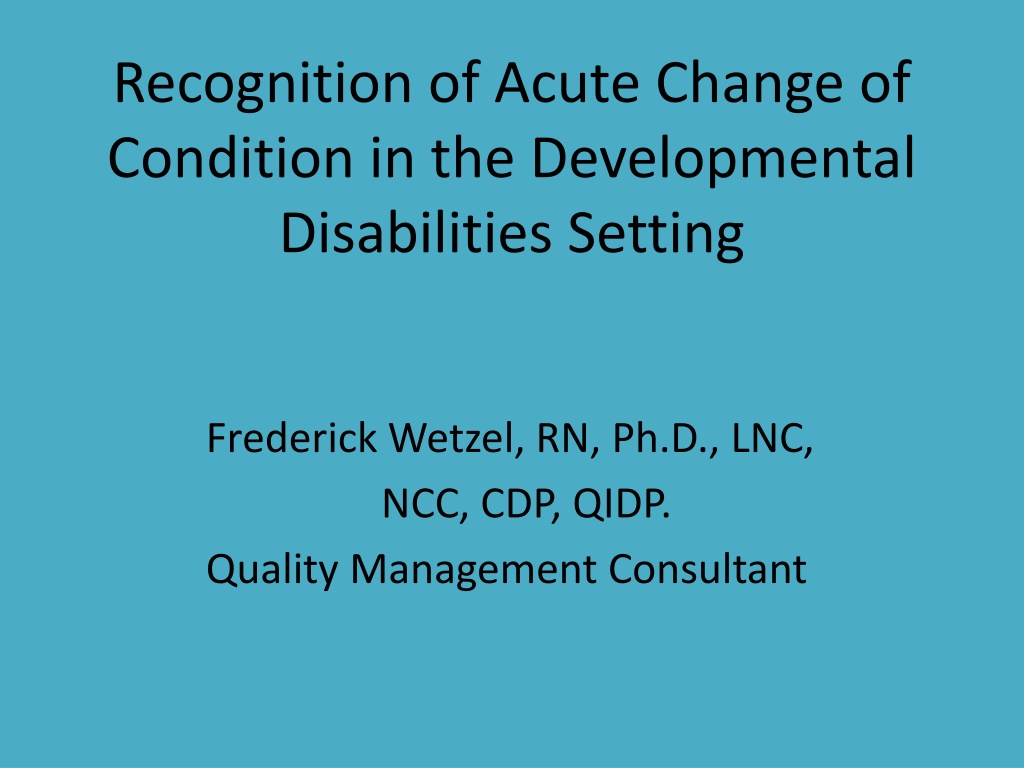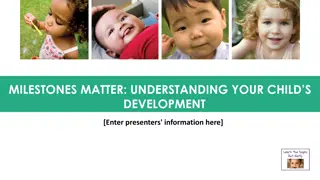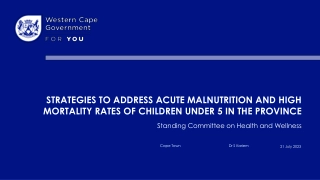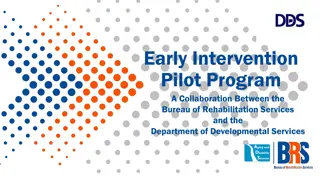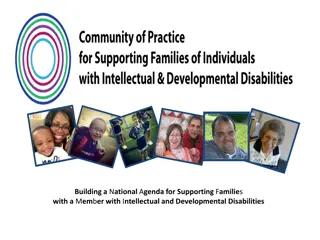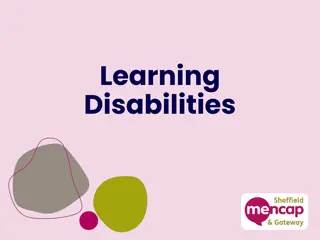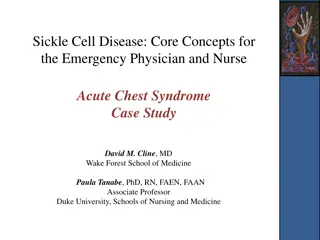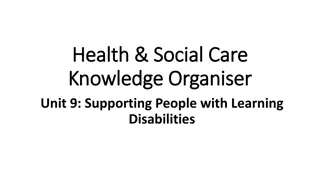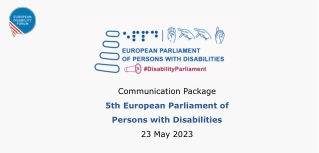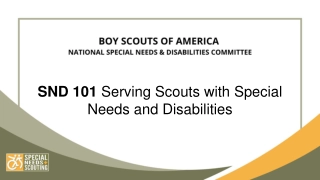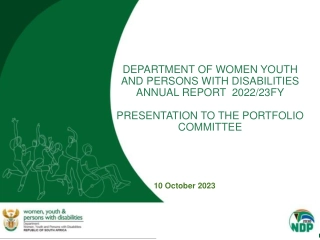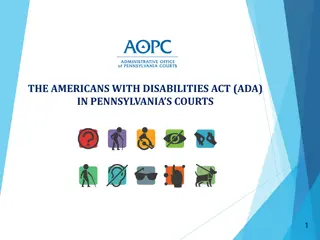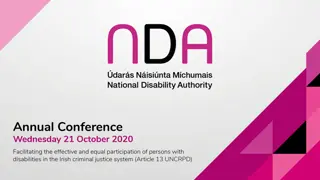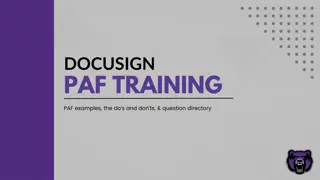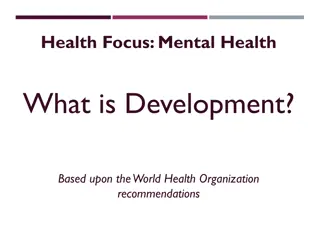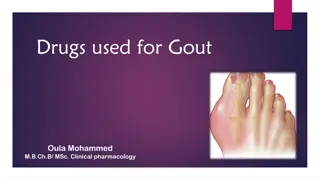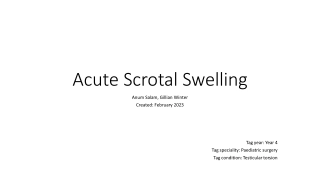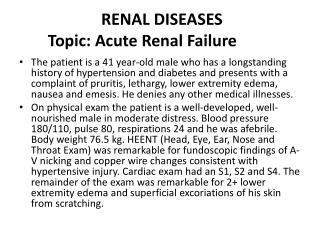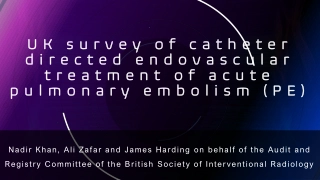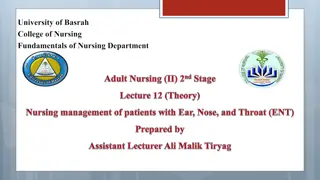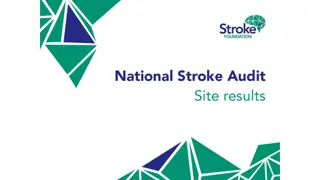Managing Acute Changes in Developmental Disabilities Settings
Recognizing acute changes of condition in individuals with developmental disabilities is crucial to prevent complications or death. Regulatory expectations highlight the need for RN supervision and immediate response to any changes in medical orders or health status. Telephone triage, guided by clinical judgment, helps RNs direct individuals to appropriate care swiftly, ensuring quality care and support for unlicensed staff.
Download Presentation
Please find below an Image/Link to download the presentation.
The content on the website is provided AS IS for your information and personal use only. It may not be sold, licensed, or shared on other websites without obtaining consent from the author. Download presentation by click this link. If you encounter any issues during the download, it is possible that the publisher has removed the file from their server.
Presentation Transcript
Recognition of Acute Change of Condition in the Developmental Disabilities Setting Frederick Wetzel, RN, Ph.D., LNC, NCC, CDP, QIDP. Quality Management Consultant
Definition An acute change of condition (ACOC), is a sudden, clinically important deviation from a patient s baseline in physical, cognitive, behavioral, or functional domains. Clinically important means a deviation that, without intervention, may result in complications or death.
Regulatory Expectations Registered Nursing Supervision of Unlicensed Direct Care Staff in Residential Facilities Certified by the Office of Mental Retardation and Developmental Disabilities (Now OPWDD) Administrative Memorandum (ADM) 2003-01 AND ADM 2015-03
Regulatory Expectations ADM 2003-01 There shall be an RN available to unlicensed direct care staff 24 hours a day, 7 days a week. The RN must be on site or immediately available by telephone. Note: Immediately available has been defined as responding within 30 minutes.
Regulatory Expectations Professional Nursing Availability (cont.) The residence RN, or during off hours, the RN on call, will be immediately notified of changes in medical orders for a consumer and/or of changes in a consumer s health status
Telephone Triage In DD facilities, telephone triage is often the primary method for RNs to manage reports of change of condition. The purpose of telephone triage is to direct the individual to the right place, at the right time, so that he/she receives the optimum treatment.
Telephone Triage Is an encounter with a caller in which an RN utilizing Clinical Judgment and the Nursing Process is guided by medically approved decision tools, to determine the urgency of the problem and to direct the caller to the appropriate level of care.
Why do Telephone Triage? Provides for improved quality of care for the people we serve. Provides professional direction and support for unlicensed direct care staff. Reduces the number of avoidable ER visits/Hospital admissions.
Why reduce ER Visits/Hospitalizations? Transfer to a hospital is disruptive for Individuals with I/DD. It exposes Individuals to risks: Under-nutrition; Hospital Acquired Infections;
Why reduce ER Visits/Hospitalizations? Skin Breakdown; Hospital Acquired Infection; Adverse Drug Reactions; Disruption of Established Routines; Loss of Established Abilities; Need for 1:1 Staffing; ER Utilization/Hospitalization is the most costly level of care.
Managed Care Emphasis In Medicaid Managed Care programs, one of the goals/standards on which providers of care are judged is the ability to reduce costs through reducing: Potentially Preventable Hospitalizations: Potentially Preventable Readmissions; Potentially Avoidable ER Visits. Some plans reward Providers for meeting goals in these and other areas.
Risk of Acute Change of Condition (ACOC) Step 1. Identify Individuals at risk for ACOCs. ACOCs are very common in individuals with I/DD. Although some ACOCs are unpredictable, many can be anticipated by identifying risk factors such as pre-existing conditions, previous complications, or the course of a recent hospitalization.
Examples of Predictable ACOCs Premature discharge from an acute care facility ( Quicker and Sicker ). Individuals with CHF, or Hypertension. Impaired Mobility. Recurrent falls. Prolonged Bed Rest. Urinary Retention,
Pre-Existing Conditions that may Predispose Individuals to ACOCs Condition Congestive Heart Failure ACOC Risks Acute Dyspnea Pulmonary Edema/Respiratory Infection COPD Fluid/Electrolyte Imbalance Hypoglycemia Diabetes GI Bleeding Acute Recurrence of Bleed UTI Neurogenic Bladder Falls Altered Mental Status New Medication
Approaches to Assessing Risk for ACOCs Approaches Determine Expected Course/Known Complications. Step Evaluate Current Condition and Status. Create a Problem List. Identify all Current Problems. Identify Risk for Poor Outcomes (Death, Skin Breakdown, Failure to Regain Weight) Identify Interventions to Reduce Risks/Prevent Complications. Identify Risk Factors.(eg. Functional/Cognitive Status, Number of DXs. Ex. Turning/Positioning, Medication reduction, reduce incidence/severity of complications.
Step 2. Describe and Document Symptoms/Condition Changes Individuals with I/DD are most likely to report symptoms to a DSP, Manager or Nurse. It is rare for an Individual to report directly to a practitioner. It is important that caregiving staff describe symptoms as accurately and completely as possible, so that practitioners may determine their significance.
Describing/Documenting (cont.) DSP/Nurse should, at minimum: Ask the Individual how they are feeling or how symptoms developed; Take Vital Signs; Determine overall condition, LOC and function.
Describing Symptoms An Individual s symptoms or test results may represent anything from normal variation to serious underlying illness. The Practitioner needs a detailed description of condition to determine whether a symptom is problematic or simply a normal or expected variant. For example, agitation may represent momentary anxiety in an otherwise calm person, or at the other end of the spectrum, acute psychosis or delirium.
Describing Symptoms Caregiving staff should describe and document the nature, extent, and severity of symptoms, abnormalities, and condition changes clearly and in sufficient detail to help practitioners distinguish their potential causes and consequences. Observation, description and documentation of symptoms must be distinguished form interpretation. Caregivers making observations may not be qualified to interpret those observations and should not attempt to do so. Appropriately qualified practitioners should follow up on those observations and document and interpret their findings.
Describing Symptoms Use correct terminology and document sufficient details to describe the observations to help practitioners compare symptoms, identify the effectiveness of specific interventions, and distinguish between similar symptoms that have significantly different causes.
Examples Hyperventilation is not dyspnea. Tremor or shaking is not a seizure. Apathy is not depression. Motor restlessness is not agitation. Fatigue is not weakness. Loose stools are not diarrhea.
Examples of Appropriate Descriptions of Symptoms General statement: Patient more agitated than usual More Appropriate/Specific: Pt. required interventions 3X this shift. Pt. not responding to redirection. Pt. refused meds 2x in last 2 days. Pt. shouting,hitting,etc.
Appropriate Descriptions General Statement Pt. is not her usual self More Appropriate/Specific Pt. not participating in activities. Pt. not interacting in usual manner. Pt. did not brush her hair and put on make-up as she usually does.
Appropriate Descriptions General Statement Pt. is not eating/not drinking More Appropriate/Specific Pt. ate only 50% of breakfast and 25% of lunch over the past two days. Pt. is not eating solid foods. Pt. seems to be having pain when chewing. Pt. is refusing fluids. Pt. has not voided in two shifts.
Appropriate Descriptions General Statement Pt. seems weak More Appropriate/Specific Pt. requires help with ADLs that she usually performs unassisted. Pt. is dropping things with his left hand. Pt. has had two non- injurious falls in the past week.
Facilitating Clear Communication in the Team Agencies should encourage effective, multidirectional communication that recognizes the value of relevant input from various sources, including family members, managers, and clinical staff, as well as DSPs. Relevant information from Day Service and Transportation Providers should also be sought.
Facilitating Communication Direct-Support Professional staff should be trained in recognition of signs and symptoms of illness and should be encouraged to freely report their observations to Nursing staff. Many times, observation by DSPs can provide early warning of Acute Change of Condition.
Facilitating Communication DSPs who identify possible ACOCs should immediately report their findings to the RN. Nurses should follow written guidelines (protocols, decision trees, Triage Manuals, etc.) to determine what signs and symptoms to report to Physicians. HOWEVER: Protocols should NEVER substitute for Nursing Judgment.
Facilitating Communication When reporting information to a Practitioner, Nurses should not assume that the Practitioner knows the Pt. well, or remembers relevant details such as current meds, etc. It is helpful to give the Practitioner a brief review of any relevant medical history.
Recommended Procedures for Ensuring Recognition of ACOCs Communication of all Pt. related information follows a defined process. All team members (not just DSPs) are expected to report findings that might represent ACOCs. In-depth discussion of ACOCs occurs at specific times. Ex. Shift to shift communication. Responsibility for entering information in the medical record is clearly assigned.
Facilitating Communication Breakdowns in communication should be promptly addressed by RNs and Supervisory staff. Poorly written notes, or notes that fail to provide important information should be addressed. Nursing Peer review is a good tool to improve communication and documentation. Reviews should be a LEARNING Tool, NOT a criticism.
PQRST Mnemonic P: Palliation, Provocation What makes the symptom better or worse? Q: Quantity, Quality How much is the patient bothered by the symptom and what is the degree of discomfort?
PQRST R: Region, Radiation Where are the symptoms located? Do they move from one part of the body to another? S: Signs, Symptoms What signs and symptoms coincide with the primary findings? (For example, is pain accompanied by sweating and elevated pulse?)
PQRST T: Temporal Relations What changed around the time of onset of symptoms or condition change? What other active problems are on the Pt.'s problem list? Have the same or similar episodes occurred in the past? What was happening at those times? What solutions have or have not been effective previously? Have the Pt.'s meds or physical routine changed recently?
Step 3. Define the Pt.'s stability and Identify why the Situation is Problematic Many symptoms and abnormalities are seen in LTC populations. However, only some of those are problematic, and only some of those are that are problematic require or are likely to respond to treatment. For example: Blood Pressure may fluctuate without requiring immediate attention; Alertness or functioning of a Pt. with Alzheimer disease may fluctuate throughout the day; An Individual with COPD or CHF may periodically breathe irregularly or with some difficulty.
Step 3, cont. Considerable judgment based on knowledge and experience is required to distinguish symptoms which may not require intervention, from symptoms that are both problematic and likely to respond to treatment. When an Individual is observed to have a condition change, it is common for caregivers to call a practitioner immediately, or rush the person to the ER. In many cases, these actions are premature.
Step 3 cont. Unless an Individual s condition is deteriorating rapidly, or vital signs are markedly abnormal or unstable, the RN generally has ample time to conduct an assessment prior to initiating treatment or transfer. Isolated findings or test results rarely indicate a need for hospital transfer. There is generally time for decision making, unless the issue is emergent. Standardized protocols for decision making are available, and should be used.
HOWEVER: Standardized protocols should NEVER be used as a substitute for Nursing Judgment. The expectation is not for Cookbook Medicine But rather for use of informed judgment, ASSISTED by decision-support tools. When in Doubt, send them out!
Categories of Symptoms that may help to define ACOCs Respiration: Observe for the following; Respiratory rate >28 BPM or< 12 BPM. Marked change from usual respiratory pattern/rhythm; Irregular breathing, long pauses between breaths, audible noises related to breathing; Struggling to breathe (gasping, using accessory muscles of the neck)
Categories of Symptoms Temperature: A range of 97 F- 99 f is considered average. It is good to establish a pt.'s normal range; A sudden or rapid change may indicate an ACOC; After an isolated temp reading outside the pt. s normal range, repeat reading Q4H for 24 hours and assess for other S&S; Hypothermia may also indicate an ACOC;
Categories of Symptoms Blood Pressure: Good to establish normal range for the Individual; Normal is less than 120 mmHg systolic and less than 80 mmHg diastolic; (Amer. College of Cardiology, 2018. A change in BP is more often a symptom than a cause of an ACOC. Isolated BP elevations are generally not significant; A decrease in systolic BP >20mmHg when moving from a prone to a seated position, or a seated to a standing position, signals orthostatic hypotension; Significant decrease in BP may signal an ACOC, especially if accompanied by other symptoms. Always consider SEPSIS!
Categories of Symptoms Pulse: Normal range 60-100 BPM, can vary up to 10%. The following presentations may indicate an ACOC and should be assessed further; Sustained change from normal rate; Change in rhythm or regularity; Pulse >120 BPM or< 50 BPM; Pulse >100 BPM with other symptoms (e.g., palpitations, dyspnea or dizziness).
Categories of Symptoms Pain: The following may indicate an ACOC and should be assessed further; Pain worsening in severity, intensity, or duration, and/or occurring in a new location; New onset of pain associated with trauma; New onset of pain greater than 4 on a 10 point scale.
Categories of Symptoms Weight/Eating Patterns: An abrupt change in appetite may indicate an ACOC before a significant change in weight occurs; Rate of weight gain/loss may be a more important indicator of a possible ACOC than amount of weight gain or loss; A change in intake patterns (e.g., consuming <75% of all meals in 24 hours or <25% of any one meal) should trigger additional evaluation for a possible ACOC;
Categories of Symptoms Weight/Eating Patterns Cont.: In documentation of intake, identify both solid and liquid intake in as much detail as possible; Evaluate S&S that may suggest fluid imbalance (e.g., edema or change in edema); Acute, rapid weight gain may indicate an ACOC accompanied by fluid accumulation (e.g., acute CHF) Acute, rapid weight loss over several days should trigger concern about a hydration emergency.
Categories of Symptoms Level of Consciousness: LOC should be distinguished from aspects of cognition, such as orientation and memory; LOCs are alert, drowsy/lethargic, stuporous, and comatose. The following may indicate an ACOC and should be assessed further: Frequent fluctuations in LOC; A reduction of one level or more in LOC Hypersomnolence
Categories of Symptoms Weakness: New onset of weakness, or significant change from baseline may indicate an ACOC and should be assessed further; Classify weakness as generalized or localized and describe in detail.
Categories of Symptoms Falls. The following may indicate an ACOC and should be assessed further: Repeated falls on the same day; Recurrent falls over several days to weeks; New onset of falls, not attributable to a readily identifiable cause; A fall with consequent change in neurological status, or findings suggesting a possible injury An unwitnessed fall is a HEAD INJURY until proven otherwise!
Categories of Symptoms Change in Elimination Patterns. The following may indicate an ACOC and should be assessed further: Appearance of frank blood in stool, urine or vomit; Abrupt change in frequency of urination or defecation; Frequent loose stools (three or more in 24 hours); Worsening incontinence of bowel or bladder.
Categories of Symptoms Behavioral Symptoms: Significant change in nature or pattern of usual behavior; New onset of resistance to care; Abrupt onset or progression of significant agitation or combative behavior; Significant change in affect or mood; Violent/destructive behaviors directed at self or others.
